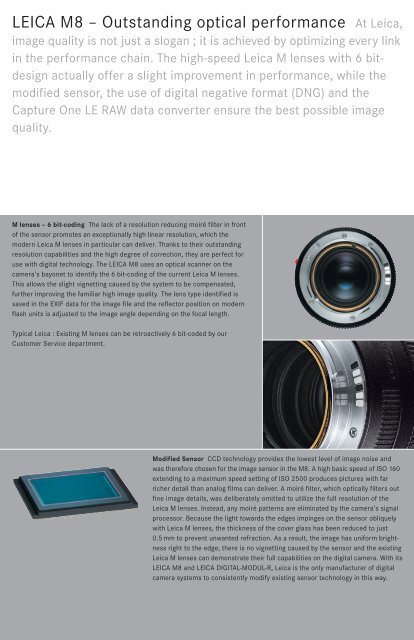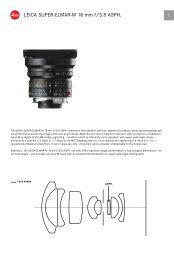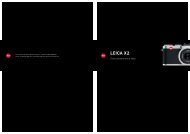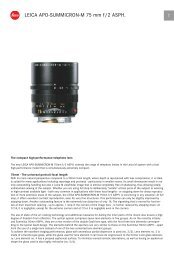Leica M System
Leica M System
Leica M System
- No tags were found...
Create successful ePaper yourself
Turn your PDF publications into a flip-book with our unique Google optimized e-Paper software.
LEICA M8 – Outstanding optical performance At <strong>Leica</strong>,image quality is not just a slogan ; it is achieved by optimizing every linkin the performance chain. The high-speed <strong>Leica</strong> M lenses with 6 bitdesignactually offer a slight improvement in performance, while themodified sensor, the use of digital negative format (DNG) and theCapture One LE RAW data converter ensure the best possible imagequality.M lenses – 6 bit-coding The lack of a resolution reducing moiré filter in frontof the sensor promotes an exceptionally high linear resolution, which themodern <strong>Leica</strong> M lenses in particular can deliver. Thanks to their outstandingresolution capabilities and the high degree of correction, they are perfect foruse with digital technology. The LEICA M8 uses an optical scanner on thecamera’s bayonet to identify the 6 bit-coding of the current <strong>Leica</strong> M lenses.This allows the slight vignetting caused by the system to be compensated,further improving the familiar high image quality. The lens type identified issaved in the EXIF data for the image file and the reflector position on modernflash units is adjusted to the image angle depending on the focal length.Typical <strong>Leica</strong> : Existing M lenses can be retroactively 6 bit-coded by ourCustomer Service department.Modified Sensor CCD technology provides the lowest level of image noise andwas therefore chosen for the image sensor in the M8. A high basic speed of ISO 160extending to a maximum speed setting of ISO 2500 produces pictures with farricher detail than analog films can deliver. A moiré filter, which optically filters outfine image details, was deliberately omitted to utilize the full resolution of the<strong>Leica</strong> M lenses. Instead, any moiré patterns are eliminated by the camera’s signalprocessor. Because the light towards the edges impinges on the sensor obliquelywith <strong>Leica</strong> M lenses, the thickness of the cover glass has been reduced to just0.5 mm to prevent unwanted refraction. As a result, the image has uniform brightnessright to the edge, there is no vignetting caused by the sensor and the existing<strong>Leica</strong> M lenses can demonstrate their full capabilities on the digital camera. With itsLEICA M8 and LEICA DIGITAL-MODUL-R, <strong>Leica</strong> is the only manufacturer of digitalcamera systems to consistently modify existing sensor technology in this way.
















